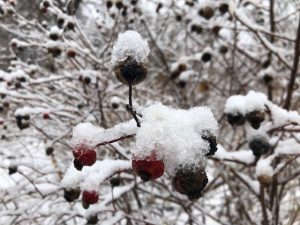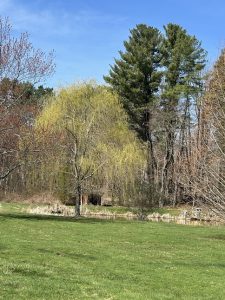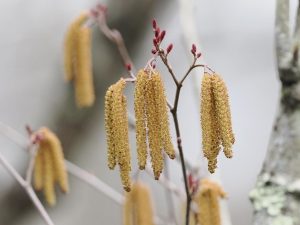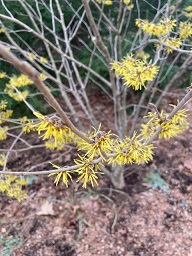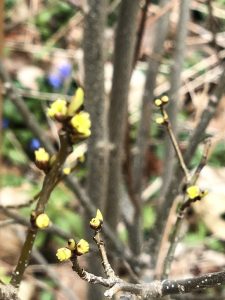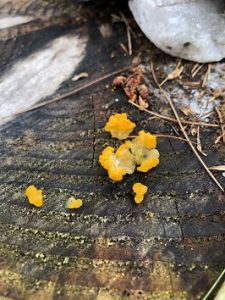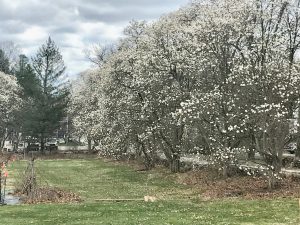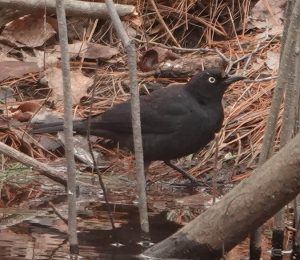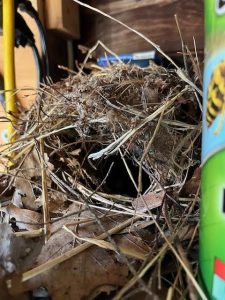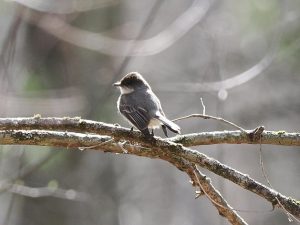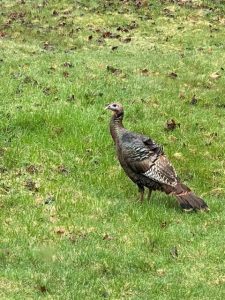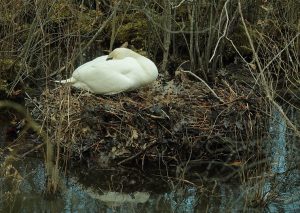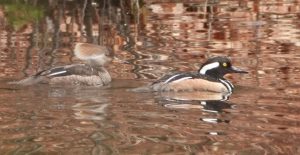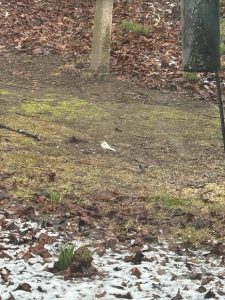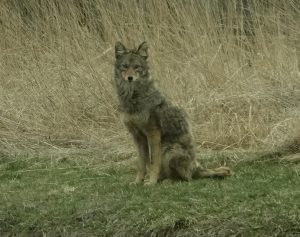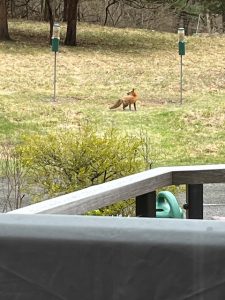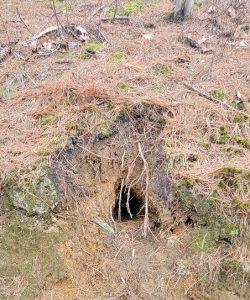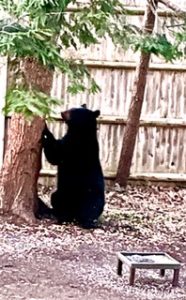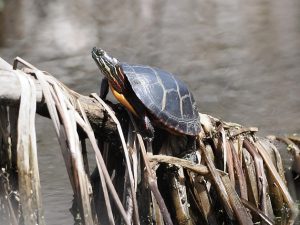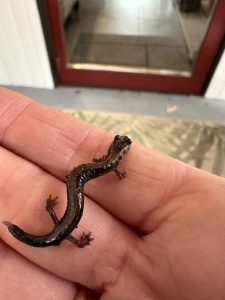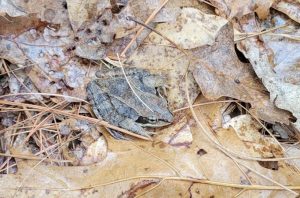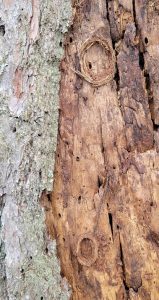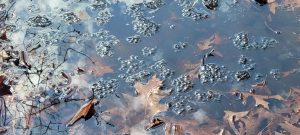Written by Gwyn Loud for the Lincoln Land Conservation Trust. She welcomes your sightings and questions at 781-259-8690 or gwynloud555@gmail.com
If “April showers bring May flowers”, we should relish gorgeous blossoms next month. Although we had summer-like temperatures in the sixties the first week of April, since then it became chilly, windy, and wet. It fell below freezing on several nights the second week of the month and on both April 11 and 12 we awoke to light snow. Average rainfall total in Metrowest for the month of April is 4.16” and as of the 8th, 3.45” of rain had been recorded, with more since then. Streams are full, vernal pools which had dried out are filling, and the aquifer is benefitting.
Spring colors are slowly painting the landscape. Lawns and fields are greening, willows are turning yellow, and red maple flowers are giving a reddish cast to the woods. Daffodils and forsythia bloom around houses and we admire the annual show of magnolias along Lincoln Rd. near the CCF gardens. Dandelions are hardy, giving us spots of bright yellow even from tough terrain such as gravel driveways. You might come across spicebush in flower as you walk a woodland trail; pinch a leaf or stem and sniff to see where it gets its name. Before long marsh, marigolds will be blooming near streams. As I wrote a year ago, “Non-native shrubs such as honeysuckle and multi-flora rose are among the first to leaf out, which gives them advantages over native shrubs. Quoting an article by researchers at Penn State, “The longer period with leaves gives invasive plants an advantage in acquiring more energy from sunlight and their leaves create shade in early spring and late fall that may limit growth of native species, such as forest ephemeral wildflowers….. This helps explain their negative impact on native tree regeneration, plant diversity and abundance.” It is garlic mustard season; signs around town remind us to pull this invasive plant.
Each week more migrating birds are arriving, some just passing through but others settling down and setting up housekeeping. Rusty blackbirds, falling into the “passing through” category, were heard sounding like squeaky rusty hinges near several swamps and will head far north to nest in boreal bogs. Eastern phoebes have arrived and might soon build a nest on a ledge over your front door. Tree swallows were seen in flocks swooping over ponds last week and will start nesting in bird boxes, and Eastern bluebirds are also starting their first nests in boxes. Chipping sparrows turned up at my feeder on April 10, the same date as last year, and American woodcocks were heard giving their distinctive peent calls in several fields around town, starting in mid-March. I am sure Carolina wrens are nesting somewhere in my barn; they seem to like man-made structures and build nests with side entrances. Robins have been observed gathering nesting material as they prepare to make mud-lined nests. Keep an eye on tree cavities, as all species of woodpeckers as well as black-capped chickadees, tufted titmice, and white-breasted nuthatches use them to nest, darting in and out of the holes silently, not to attract attention. I watched a female pileated woodpecker tossing chips of wood from a nest hole high in a dead pine tree trunk; the ground and roadside were littered with wood chips from all the excavating. A pair of American kestrels has been seen investigating a kestrel box on a tall pole at Drumlin Farm; fingers crossed they will nest!
A resident near Baker Bridge Rd. wrote, “I woke up this morning to a raucously displaying male turkey (easy to hear even with windows closed) herding a group of 7 females down the hill away from a lackluster disappointed male weakly trying to fan his own tail. The dominant male in the rising sun was quite a sight. Incredibly colorful.” Birders always look forward to the arrival of colorful wood warblers and one of the early species, a palm warbler has recently been spotted. It has a distinctive habit of constantly bobbing its tail. Looking ahead, I will put up my hummingbird feeder on May 1, hoping to welcome the ruby-throated hummingbirds after their long migration.
As for waterfowl, common mergansers, bufflehead, and common golden-eye were seen on Flint’s Pond, and wood ducks can be observed on various secluded ponds. The wood ducks will nest in tree cavities, sometimes 30 feet or more above ground. Years ago I had the good luck to see the fluffy baby ducklings leap from the hole, shake themselves off, and follow mom single-file to the nearest pond. Hooded mergansers have been observed in various locations; they also nest in tree cavities. Mute swans are nesting on Farrar Pond in the same spot as a year ago.
Some unusual avian sightings over the past month include fourteen Bonaparte’s gulls on Flint’s Pond, a common snipe in the Ricci Fields, and nine glossy ibis by a pond at Matlock Farm. A snow goose was observed in a farm field near Lee’s Bridge and birders at Drumlin Farm found a vesper sparrow and a leucistic dark-eyed junco. Leucism means a partial loss of pigmentation as opposed to albinism, which is a total loss of melanin and affects all cells in the body.
The air is filled with bird song as pairs mate, establish territories and prepare to nest. To quote from an article from All About Birds (Cornell), “Most bird watchers learn early on that it’s usually the male birds that sing to announce territory or to defend their turf—but in a new call-to-action, two researchers are urging people not to overlook females as singers. ….In 2016, a study found that in a sample of more than 1,000 songbird species from around the world, 64% had females that sing. Many tropical species and some temperate-zone species, like female Northern Cardinals, sing regularly; while others sing during specific parts of the breeding season.” (See link for full article). I shall be watching “my” cardinals carefully to observe the females singing, apparently duetting with their mates.
On Mach 13 the 2025 U.S. State of the Birds report was announced. “The report, produced by a coalition of leading science and conservation organizations, reveals continued widespread declines in American bird populations across all mainland and marine habitats, with 229 species requiring urgent conservation action. The report comes five years after the landmark 2019 study that documented the loss of 3 billion birds in North America over 50 years……Key findings from the new report show that more than one-third of U.S. bird species are of high or moderate conservation concern, including 112 Tipping Point species that have lost more than 50% of their populations in the last 50 years….. ’There is no doubt that the 2025 State of the Birds report is cause for alarm,’ said Jeff Walters, the conservation committee co-chair at the American Ornithological Society, ‘but it is also cause for hope. Public interest in birds and the economic benefits from birding are at unprecedented levels, as is the information available about the status of each and every one of our bird species. ‘ ” Click the link below to read more. On our properties, we can each do what we can to help birds, with actions such as avoiding pesticides and herbicides, planting bird-friendly shrubs and trees, leaving weedy “wild” areas alone, letting tree snags stand, setting up bird houses, and turning off outdoor lights at night.
Our local mammals are all in the process of giving birth and rearing young, with varying times according to species. We probably do not give much thought to the meadow vole, but they are very prolific, having up to seventeen litters per year, any time from March through the following January. This is a survival strategy, as voles are common prey for many animals, including hawks and foxes. The most exciting recent mammal sightings were of two black bears (possibly it was the same one in two places). The first sighting, on April 8, was from a backyard at the corner of Rt. 117 and Merriam St. (very close to the Lincoln line). That bear, which looked full-sized, took down the family’s bird feeders. The second sighting, a few days later, was from a trail cam by a house on Old Cambridge Turnpike, near Deerhaven Rd. It is well known that male black bears, probably born farther west in the Commonwealth, branch out in the spring , searching for new territory. Trail cams in several locations have picked up muskrats, opossums, bobcats, deer and coyotes. A young woodchuck emerged from beneath my neighbor’s barn; it’s very cute as long as it does not wander into my vegetable garden.
Any day now we should hear the mating calls of American toads, sounding like high thin trills floating on the air. Will Leona, Conservation Ranger, led two public programs at vernal pools and wrote, ‘We saw fairy shrimp, wood frog eggs, salamander eggs and some other insects and invertebrates. I have seen a decent amount of spotted salamander egg masses around Lincoln, but not huge numbers. The wood frogs have seemed to have carried on with business as usual and left behind many large rafts of eggs.” One of my neighbors found a redback salamander under a planter. This species is our most common salamander, is terrestrial, and does not lay eggs in water, but under logs. It forages for food at night looking for small invertebrates on the forest floor.
Turtles are more evident now that the weather warms. Look for painted turtles soaking up the sun as they lie on partially submerged fallen trees in the water.
HAPPY EARTH. DAY! The first Earth Day was on April 22, 1970, fueled by concerns about our environment in the 1960s. Rachel Carson’s book, Silent Spring, published in 1962 was key in awakening the public’s eyes to the dangers of pesticides. A strong environmental movement was born and led to the creation of the EPA, the Clean Air Act, the Clean Water Act, and the Endangered Species Act, among many other initiatives. In recent years a major focus of Earth Day has been combatting climate change. As our current administration works to roll back environmental protection, health and safety regulations, and green energy initiatives, I hope readers will support the goals of Earth Day in all ways possible.
Links
To read about female bird songs
To read more about the 2025 State of the Birds
To read more about the history off Earth Day
Fox with Wood Frog Chorus, Will Leona



